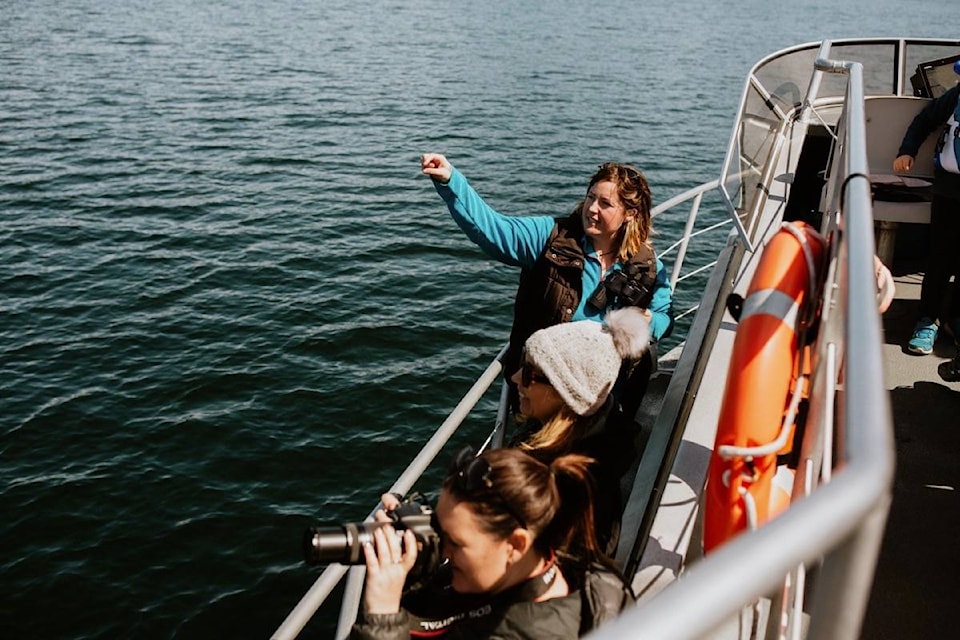A humpback whale appearing to have become entangled in fishing gear near Campbell River looks to have broken free on its own, but the event shows how boaters should respond to help.
While leading a whale watching tour on Aug. 9, Kaitlin Paquette, marine naturalist with Discovery Marine Safaris, noticed a pair of whales off Cortes Reef. Paquette considered their observed behaviour atypical, as they were not showing any flukes or diving.
“I thought it was kind of strange that they were sitting at the surface for so long,” she said.
Reviewing her photos, Paquette saw two lines running across the back of one of the whales just before their dorsal fin — indicative of a possible entanglement with fishing gear. The whale was later identified as ‘Lorax,’ a humpback born in 2014 frequenting the waters around Campbell River.
Paquette contacted the Department of Fisheries and Oceans (DFO) marine reporting line, and the ship’s captain radioed the coast guard and other whale watchers in the area.
“We then stayed with the whale as long as we could, until another whale watching company was able to take over observing — just because it’s important to keep eyes on them and make it easier to catch back up with them,” she said.
Thanks to Paquette’s quick thinking, Fisheries and Oceans were able to assess the whale later that day, explained Paul Cottrell, DFO’s marine mammals co-ordinator who specializes in responding to entanglement events.
“We were able to get up there within an hour and get on site,” he said.
Fortunately, there was no subsequent sign of fishing gear around the whale.
“It first appeared the animal had a couple of wraps around its dorsal side, between the blowhole and dorsal ridge,” said Cottrell. “We think the gear likely came off on its own.”
There remains a possibility markings on the whale, possibly scarring from a previous entanglement, could have been mistaken for fishing gear. Regardless, Paquette responded in the best way to help the situation, he said.
DFO will continue to monitor the whale, with the help of others on the water.
“We rely on all these great eyes and ears out there — the whale watching community has been tremendous and recreational boaters have helped too,” he said.
The event highlights the importance of responding correctly to a possible entanglement — focusing on reporting and documentation, rather than direct intervention.
Responding to entanglements is a job for experts, explained Cottrell, who has performed 50 disentanglement over the past decade.
“It’s quite dangerous removing gear from a large whale,” he said. “We have specific protocols and I have specific tools and cutting instruments that I use. You also need a support boat to accompany the lead rescue boat.”
Not only is intervening without the proper tools and training dangerous, it can hurt rescue efforts too.
“Every year, there’s a number of incidents where members of the public have cut off a trailing buoy, and then it’s very difficult for me to put a working line on,” he said. “It’s very frustrating when that happens, where someone has gone in thinking they’re helping, but they’re actually hindering — possibly killing that whale.”
If anybody sees an injured, distressed or entangled whale they should call the DFO’s marine mammal incident reporting hotline (1-800-465-4336) or contact the Canadian Coast Guard via radio VHF channel 16.
People should know what to do — and what not to do — to give whales in trouble the best chance of survival, explained Jackie Hildering, humpback researcher with the Marine Education and Research Society.
One of the biggest challenges of responding to an entanglement is finding the whale again after they are first sighted, she said. Because of this, recording as much information about the location and the whale (including photos and video) is important. Boaters should also try to stay with the whale for as long as possible, while maintaining the required 100-metre setback from it.
While those seeing a whale in distress might think they should try to free it right away, entanglements generally affect whales through long-term impacts, such as reduced movement and feeding ability or infection from wounds, she said.
“The whale is usually not facing an imminent risk,” she said. “The best thing to do is be sure the whale can be found and that the appropriate expertise and equipment gets to it.”
READ ALSO: Troubling trend of drones buzzing B.C. marine mammals leads to DFO warning
Whale experts: death of young humpback shows impact of ship collisions on species
sean.feagan@campbellrivermirror.com
Like us on Facebook and follow us on Twitter
